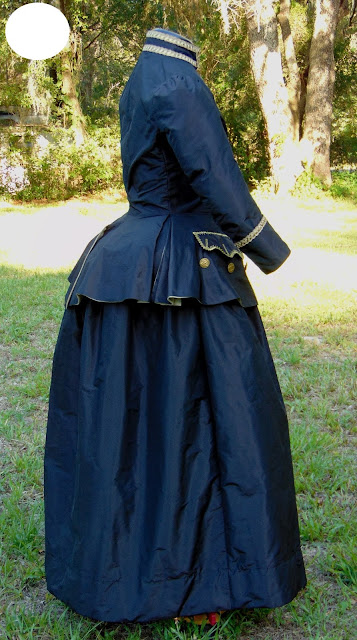Fabric: 100% silk taffeta, dark brown (not blue. Damn camera...). Lining is done in a ramie linen (grass linen) and Tencel blend.
SOLDAvailable on Etsy HERE
Measurements:Chest - 36.5"
Waist - 31"
Hip: Free
Hem: 40" at front, 43" at back (cut for bumroll)
Back Width: 14"
Bicep: 15" max
Sleeve: 22" from top of armhole seam to cuff
Alterations From Tailor's Guide Pattern
I made several alterations not just to sizing, but also to looks.
- Standing collar rather than folding collar
- cut to be left open at collar and top 3 buttons.
- Re-positioned pockets to front. Pattern has them far back, with pocket flaps almost vertical; I didn't like it.
The Pattern
The first thing you need to know about this pattern going in is that the sizes are in broad groups:
Small, Medium, Large, and X-Large.
Now, since your riding habit should be rather close fitting, it's most likely you will have to do a mock-up first and make alterations. Any alterations you make to the waist will then have to be made to the skirt panels as well so the pieces match up. Take special note of the following fit issues:
- Sleeves run very tight. Recommend widening them.
- Also widen the cuff pieces to accommodate changes in the sleeve width.
- Sleeves also run shorter than average. Lengthen.
- Collar is smaller/narrower than average in all sizes.
- Back pieces run wide. If you want a more relaxed fit for movement, this is fine, but you may still have to alter at the center back waist level.
- I recommend making any alterations to the skirt panels at the center fronts and center backs. It's easier to just not mess with the pleat marks on the sides.
Skirt Pleats
(above) The layered pleats of the front skirt section are laid over a portion of the back skirt panel, by about 1.5" (it's all marked on the pattern pieces). You may want to add a narrow strip of stiff interlining where you plan to make these pleats (something like buckram) if you're using a fabric that does like the hold pleats well. The buckram would keep everything in line. This method is also common when doing the vent pleats on men's coats of this era.
(also above) You can see the bodice lining hand slip-stitched over the waist seam. Also, to the far left, you can see the pocket. This is just a simple rectangle, and not the shaped pocket piece that comes with the pattern. When I re-positioned the pocket, that piece was no longer suitable, so I just did the pocket as one would normally do a square welted pocket.
Pockets
The pockets are done with the same dark brown silk taffeta as the rest of the habit. They are worked from the outside, through the outer fabric and lining together. The pattern calls for the pocket actually being sandwiched between the lining and fashion fabric, but I wanted the extra working weight of two layers. Also, it's so much easier to fix a pocket later if it's exposed inside. =)
The pocket flaps are done with faux buttonholes in an aesthetic common in the 18th century. It's weird to out modern eyes to have fake buttonholes, and then buttons below them where they couldn't possibly reach, but...that's what they were into. The extant pieces and paintings show it without a doubt on both men's and women's clothing.
The faux buttonholes are done with gold metal loss, laid down and wrapped over in a form of couching.
The trim around the flaps is stitched on by hand. All the visible stitching on this habit was done by hand.
Petticoat
Taffeta is a beautiful fabric, and one of my favorites, but it has its bad points. For one, the light-weight, crispy nature of taffeta makes it a pain in the ass for skirts. There's no real weight to keep the skirt in the position it belongs. Because of this, I highly recommend facing or weighting taffeta skirts in some way to help give it some downward guidance.

(above) I added a 4", double layer hem facing of black linen to help keep the petticoat where it belongs. The hem is hand stitched with small "pick stitch" barely visible from the outside.
(above and below) The petticoat length is formed at the waistband, leaving the hem straight all around. This one is formed for a modern bumroll.
40" at the center front
41.5" at the sides
43" at the center back.
Finished
*Shown over a moderate bumroll, under-petticoat,
and with torso padded to reflect the 18th century shape.
**Again, those pictures taken indoors best reflect the true
color of the garment.






























The photos are blue because of the white balance. The taffeta is "reflecting" the light, which is blue (rather than, say, yellow or greenish from artificial lights) and so dark colors like black or very dark brown come out looking navy. You can fiddle with your camera's white balance options to find one that works better, or fiddle with the white balance in post (Photoshop, Lightroom, etc.) to reduce the blue tones and re-balance the colors.
ReplyDeleteAll that being said, the riding habit looks epic in both brown and blue ;-)
Thank you so much! I did the unthinkable and actually broke out the instructional manual for my camera to see how to do the white correction. Worked perfectly! I'm posting a blog for a different garment I did in the same taffeta today, so you'll see how the photography advice worked out ;)
DeleteI'm with Lauren. I think I am going to shop around for a lightweight green wool. I would love a Redingote! (Did I spell that right?) Lovely.
ReplyDeleteOoooh...a green wool would be beautiful for a riding habit. And yes, redingote is right =) LOL.
Delete